Patreon CHORDS 101 Series
Seventh Chords
- Page Two -
This series of Musicarta web pages shows you the best way to learn and practice the five types of seventh chord.
This is the second of four pages in this module. If you're coming back after a break, revise Page One.
|
Seventh chords nav |
On Page One, you counted four types of seventh chord which occur naturally on the white keys- the scale degrees of C - and added the all-minor-third diminished seventh chord.
What you discovered is summarised in this table.
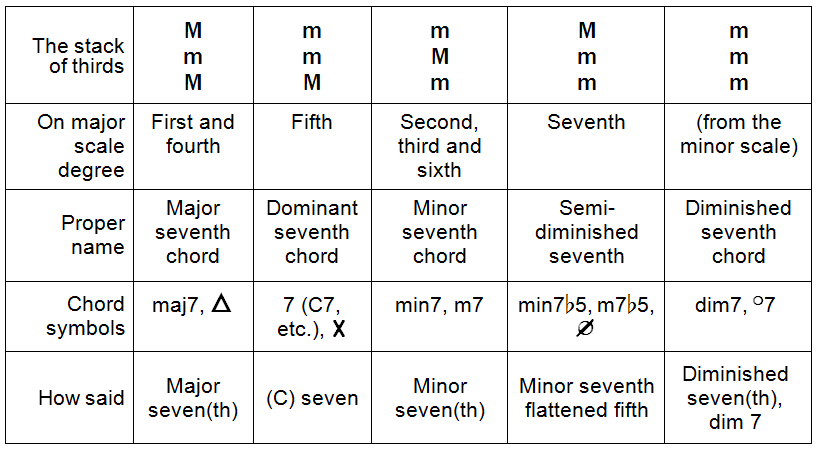
Resources
To study this module effectively, you need hard copies of the Musicarta Seventh Chords master diagram:
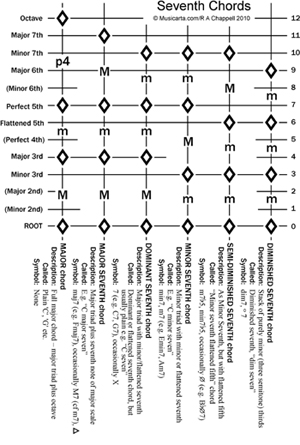
And the 'evolutions' in C and B flat.
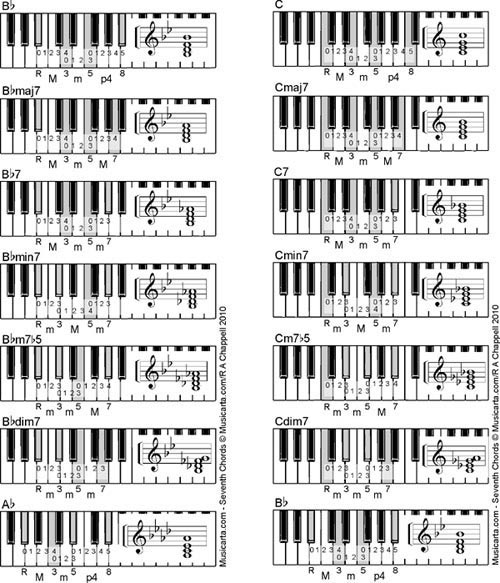
The Musicarta Seventh Chords keyboard drill
Now we are going to work through a drill for forming the five kinds of seventh chord on root C. Musicarta calls this series of seventh chords an ‘evolution’.
This drill starts from a four-note plain major chord (with the root repeated at the top). Then the chord tones are lowered one by one a semi-tone at a time until the chord has contracted to a diminished seventh chord - the smallest seventh chord.
That last chord falls to a new major chord a whole tone lower - the B flat chord - and the start of another possible evolution.
Here is the teaching video for the Seventh Chord Drill. Follow along.

Here are the numbered steps (numbers under the chords)
-
1. You play the full C major chord.
2. You lower the top note a semitone to make a C major seventh chord.
3. You lower the top note again to make a ‘plain’ C seventh chord.
4. You lower the third of the chord to make a C minor seventh chord.
5. You lower the fifth of the chord to make a C minor seventh flattened fifth chord.
6. You lower the top note again to make a C diminished seventh chord.
7. You play a full four-note major chord on Bb, a whole tone below the C chord you started with.
Go through this evolution at least two or three times. The music below shows the evolution in C written out conventionally for two hands.

To better associate the sound of the chords with their names, say the type out loud as you play through the series.
-
1. “Major”
2. “Major seventh”
3. “Seventh (dominant seventh)”
4. “Minor seventh”
5. “Minor seventh flattened fifth (semi-diminished seventh)”
6. “Diminished seventh”
7. “Major”
You can say these names to yourself if you want, but out loud is better.
The evolution in B flat
Before playing the evolution in B flat, study the following diagram.
In root position, seventh chords are stacks of three thirds - either major (four semitones – designated M) or minor (three semitones – designated m).
We can see this vital semitone count clearly in the diagram, which shows one 'evolution'. (The first chord is not a seventh chord but your starting four-note major chord.)
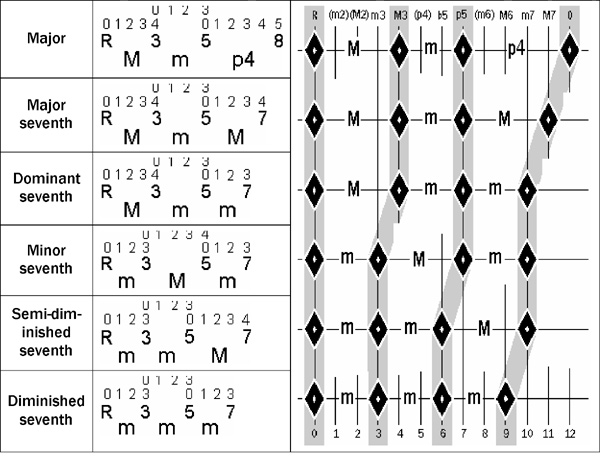
The sequence of five seventh chords on the same root plus the line-and-diamond diagram on the right above shows the chord ‘shrinking’ from the original full major as it goes through the various combinations of major and minor third.
Look for that shrinking process as you play along with the video demonstrating the evolution in B flat.

-
1. Play the full Bb major chord.
2. Lower the octave a semitone to make a Bb major seventh chord.
3. Lower the top note again to make a ‘plain’ Bb seven chord.
4. Lower the third of the chord to make a Bb minor seven chord.
5. Lower the fifth of the chord to make a Bb minor seven flattened fifth chord.
6. Lower the top note again to make a Bb diminished seventh chord.
7. Play a full four-note Ab major chord (root a whole tone below).
Preparing the moving note
For a smooth run through the chords you need to know which voice (chord tone) is going to change next.
Here is the line-and-diamond diagram with the about-to-move note circled.
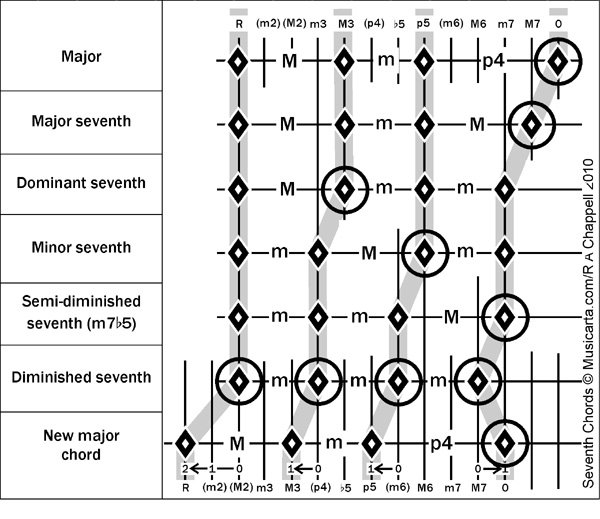
The notes move in this order.
- Top note falls from octave to major seventh.
- Top note falls from major seventh to dominant seventh.
- Second note up falls to a minor third.
- Second note down falls to a flattened fifth.
- Top note falls again to a diminished seventh.
In order: Top, top, second note up, second note down, top.
Play an evolution in A, following that sequence carefully.
Try to play any series of seventh chords from one major to the next using just the diagram and dropping (from a four-note major chord) the top note, top note again, second note up (the third), second note down (the fifth) and top note again a semitone at a time.
Say the seventh-chord qualities you arrive at each time.
You would hope to start actually hearing the series of seven chords as you look at this diagram. You will probably have to practice to make it happen. You can prepare the way by just listening to the performances in this module with the diagram in front of you.
Now go on to Page Three of the series to run
through some three-position evolutions.
|
Seventh chords nav |
Hope you're enjoying studying with Musicarta! Come back soon!
|
OUT NOW! |
THE MUSICARTA BEAT & RHYTHM WORKBOOK At last! An effective approach to keyboard rhythm & syncopation skills. Learn more! |
ONLY $24.95! |
PATREON |
The MusicartaA methodical approach to keyboard syncopation for
|
PUBLICATIONS
exciting keyboard
creativity courses
CHORDS 101
WORKBOOK

~HANON~
video course

Musicarta
Patreon
PENTATONICS
WORKBOOK
video course

Creative Keyboard
video course

BEAT AND RHYTHM
WORKBOOK

- Volume 1 -

12-BAR PIANO
STYLES WORKBOOK

MUSICARTA MODES
WORKBOOK

PIANO STYLE

CANON PROJECT
video course

VARIATIONS
video course


- Piano Solo -
video course

- Piano Solo -


YouTube playlists


